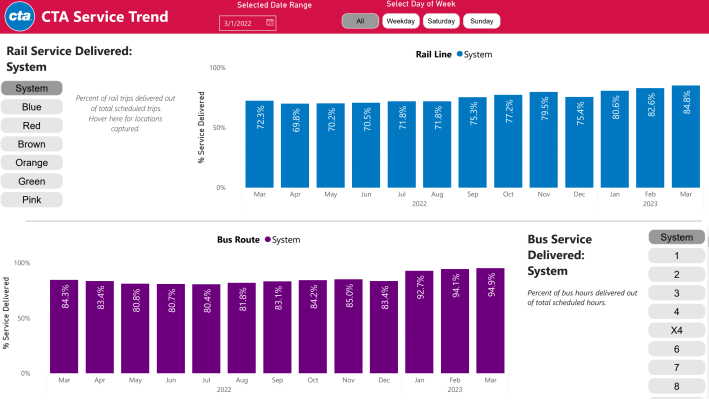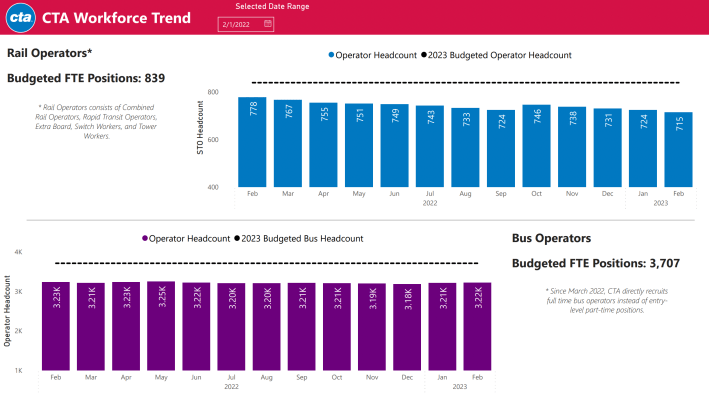The CTA's latest Meeting the Moment Scorecard touts continued improvement to the system's percentage of scheduled service delivered (POSSD) and other positive metrics. The report also includes new info about how bus and train operator hiring is going.
But transit advocates from the grassroots group Commuters Take Action say the reliability numbers are unimpressive because they've been brought about through cuts to the schedules. They add that, given workforce attrition, the agency needs to dramatically pick up the pace of hiring if it's ever going to get staffing back to pre-pandemic levels.
Latest reliability metrics
According to the CTA, instances of riders suffering through waits for 'L' trains that are two or three times the scheduled headways fell for the sixth month in a row.
- Double headways fell to an average of 84 incidents each weekday, compared to 158 before schedules were "optimized," i.e. cut, last October to improve POSSD numbers.
- Triple headways dropped to an average of 12 instances each weekday, in contrast to the 29 before the October schedule cuts.
The agency says those numbers are even better for bus service. Double and triple bus headways reportedly dropped by over half, from 12.3 percent of all waits in December to 5.6 percent in March.
Moreover, according to the CTA, March POSSD improved over the previous month:
- Bus service delivered: 94.9 percent in March, versus 94.1 percent in February
- Rail Service Delivered: 84.8 percent in March, versus 82.6 percent in February

"The primary contributor to service challenges is the nationwide shortage of transit-industry frontline workers," the CTA said in a statement. "Additionally, when last-minute call-offs occur—and backup workers are not available—CTA can’t put out all scheduled train trips customers deserve."
New info on hiring
The CTA promised that from now on the scorecards will "provide improved transparency into the agency’s workforce metrics, including monthly hiring and attrition rates for the past 13-months for bus operators, as well as flaggers and rail operators."
As of late February, there were 715 rail operator jobs filled filled, but 839 full-time positions budgeted, which means the system was down 124 train drivers.
The agency says it offers regular training classes for current rail employees, such as flaggers and customer assistants, to become train operators, and recent classes have been at capacity. That suggests there's something of a training bottleneck, so the agency should be offering more classes.

Meanwhile, the CTA says 3,220 full-time bus operator positions were filled as of late February, out of 3,707 budgeted full-time jobs, so the system was down 487 full-time bus drivers.
The CTA says in 2022 it hired 452 bus operators. The agency has hired 225 full-time bus drivers so far in 2023, out of a goal of 700 bus operators for the year, which will help fill the shortage of roughly 600 total full-time and part-time bus operators. This includes having additional workers available to cover absences.
(After publication of this article, a CTA spokesperson clarified, "At the end of 2022, CTA had a deficit of almost 600 bus operators. Since then, we have successfully onboarded 225 new bus operators. The goal of 700 new bus operators will continue to lower our deficits compared to our budgeted headcount, but it will not net CTA 700 more operators by year-end due to attrition." They also noted that while the hiring 225/700 data are through March 31st, the headcount/attrition charts are through February 28th.)

CTA Action responds
Commuters Take Action, which analyses CTA schedules and tweets out POSSD numbers daily, posted a statement responding to the latest scorecard. "For months, President [Dorval] Carter has been giving bullish updates on how service is improving thanks to aggressive hiring. However, it is now more than evident that any [POSSD] improvements are almost entirely due to service cuts. Still missing from the report is a breakdown of how CTA’s so-called “service optimizations” have actually affected each route’s scheduled service frequency.
The statement noted that on March 26 the CTA relatively quietly cut scheduled service for the third time since October. "A few weeks into effect, every line except for the Orange Line has had multiple days with service delivery below 90 percent."
Clark & Lake. 20 mins to get outbound Blue Line. And there are ELEVEN private security guards shooting the s**t on this platform. This is not the solution. @ctaaction @cta pic.twitter.com/SdLSHdTzwJ
— Chris Ridgeway (@ridgewaychris) April 12, 2023
The statement applauded the inclusion of more detailed info on staffing levels. "After months of lack of transparent updates on operator hiring, the CTA finally included statistics on the vital bus and rail operator staffing levels."
"However, being able to see these numbers doesn’t provide such an optimistic outlook," the group added. "Compared to a year ago, the CTA has almost 10 percent fewer rail operators and virtually the same number of bus operators." CTA Action blamed these numbers on "the CTA’s inability to modernize the rail operator hiring and training process... The CTA is able to graduate rail operator classes of 20 students approximately every two months. With current attrition trends, these new operator additions would barely break even, but would not get the agency any closer to restoring the full budgeted headcount."
In short, while the CTA continues to make increment progress in reliability and staffing, Commuters Take Action says it's not nearly enough to get the system where it needs to go.





